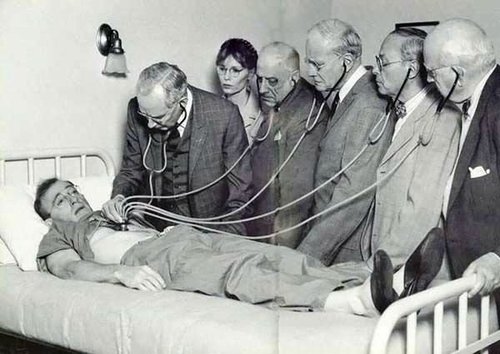Physical exam is struggling more and more to find its place in modern medicine. Numerous contemporary studies have shown limited or no diagnostic value of frequently utilized physical exam components, including breast and pelvic exams, but also many other general exams.
There are at least three things occurring simultaneously that produce studies that show poor utility of these exams.
- Physical exams are being done on populations in whom they should not be done, meaning that there is a low pretest probability that the potentially discovered abnormality is truly abnormal. This leads in turn to over-diagnosis or misdiagnosis and the harm caused by this shifts the scales in studies towards less utility and more harm. An example of this is routine pelvic exam. If the exam is over-utilized in a low-risk population, such as asymptomatic young women, then almost every discovery of an abnormality will be a false-positive; these women may then be subjected to more invasive tests or even surgery.
- Physical exam sensitivity and specificity is being compared in modern studies to the sensitivity and specificity of radiologic or other types of testing. It’s hard to imagine a study where a stethoscopic exam of the heart is found to be equivalent to an echocardiogram; but this doesn’t mean that the stethoscope has lost its purpose. Instead of viewing physical exam as a competitor to more expensive and technology-based tests, it should rather be viewed as a tool that helps to decide whether the more expensive test is necessary. In other words, physical exam should be viewed more as a screening test, and its value is based on the pretest probability (determined usually by the history). If the heart sounds normal, don’t order the echocardiogram; if you hear a murmur, then order the echo as appropriate.
- Physical exam, as it loses importance in the minds of clinicians, is done incorrectly more often than not. With the crutch of diagnostic imaging and other tests always available, physicians have lost respect for many types of physical exam and deemphasized them in their practices and in their minds. Despite this, physicians often continue to do these exams out of routine and for billing purposes; but physicians often don’t trust their own abilities at performing exams. Breast exams are a good example. Many studies have shown that clinical breast exam is of little or even no utility. Physicians almost never trust their ability to do a breast exam correctly and they almost always defer to imaging, particularly when there is a patient complaint of a mass or lump. But the reality is that most physicians don’t perform breast exam correctly; when this is observed in studies, then breast exam appears to have little diagnostic value and what value it has is outweighed by the harms of false-positive diagnoses.
So, physical exam is often done on the wrong patients, its value measured incorrectly, and the technique performed incorrectly. This is the perfect storm for making physical exam obsolete. What can we do about these three things?
- Physical exams should be performed only on patients who have a reason to have them, so that the pretest probability is sufficiently high to make the results meaningful. Don’t do a rectal exam on a 20 year old asymptomatic patient, for example.
- Physical exam should be valued for what it is: something that helps to move the diagnostic process along. It helps to move things up or down on your differential diagnosis and direct the most efficient utilization of resources. This also means physical exam should be performed intentionally and for a specific purpose. If you suspect otitis media based upon the history, then perform an ear exam.
- The last point requires physicians to work hard to become more competent at physical exam.
This brings us to the Stanford Medicine 25, found here. This is a valuable resource for everyone from medical students to seasoned physicians. Most of the 25 physical exam components listed are often poorly done by physicians. This resource provides a review of the technique and the purposes of each, often with videos, etc.
Bon appétit.

